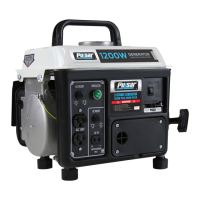Don’t Overload Generator
Make sure you can supply enough rated watts and surge watts for all electronic devices connected to the generator. Rated
watts refer to the power a generator must supply to keep a device running. Surge watts refer to the power a generator must
supply to start an electronic device. This power surge for starting a device usually lasts between 2-3 seconds but this
additional output must be taken into account when selecting the electronic devices you plan to attach to the generator. To
prevent overloading the generator take the following steps:
1. Add up the total rated wattage of all electronic devices that will be connected to the generator simultaneously.
2. Estimate surge watts by adding the item(s) with the highest output (it is unnecessary to calculate the surge output
for all devices as they should be connected one at a time).
3. Add the Surge Watts to the total Rated Watts in step 1. Keep total load within generator’s power capacity.
Operating voltage and frequency requirement of all electronic equipment should be checked prior to plugging them into
this generator. Damage may result if the equipment is not designed to operate within a +/- 10% voltage variation, and
+/- 3 Hz frequency variation from the generator name plate ratings. To reduce the risk of damage, always have an
additional load plugged into the generator if solid state equipment (such as television set) is used. A power line
conditioner is recommended for some solid state applications.
Wattage Reference Guide
(Wattages listed are just approximations. Check electronic device for actual wattage)
18 CU Ft Refrigerator / Freezer
Electric Range (1 element)
Personal Computer (17” Monitor)
1000W Quartz Halogen Work Light
Electric Drill (½ HP, 5.4 Amps)
Garage Door Opener (⅓ HP)

